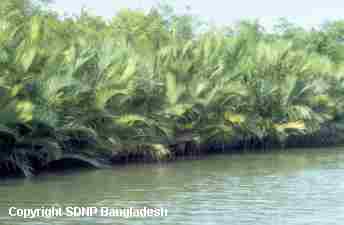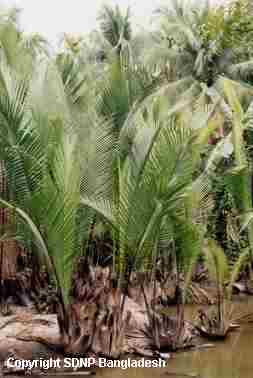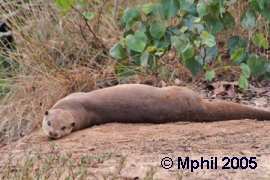Habitat of the Smooth-Coated Otter

 Smooth-Coated Otters need larger bodies of water than the small-clawed otter. The
IUCN Red List 2000
represents it
as a lowland species, but
Harris (1968) records that historically it was found in Yunnan Province, China, at 6000', and it
is present today in Nepal. In fact, the Smooth-Coated Otter seems to be quite an adaptable species.
It even lives in the semi-arid Sind, and the Deccan Plateau of India. They are also common in the lowland
swamp forest of the Sundarbans of Bangladesh. These otters also make use of coastal mangrove
swamps, even being seen swimming out to sea, and in Sumatra are even known as "Sea Otters".
They also need access to fresh water for drinking and for coat maintenance by washing out the
salt as Eurasian Otters do (
Wayre in IUCN, 1977). They make a great deal of
use of large, forested rivers, lakes, some kinds of swamps, man-made canals and flood storage reservoirs
(
Haque & Vijayan, 1995). They find rice
paddies to be very agreeable habitat.
Smooth-Coated Otters need larger bodies of water than the small-clawed otter. The
IUCN Red List 2000
represents it
as a lowland species, but
Harris (1968) records that historically it was found in Yunnan Province, China, at 6000', and it
is present today in Nepal. In fact, the Smooth-Coated Otter seems to be quite an adaptable species.
It even lives in the semi-arid Sind, and the Deccan Plateau of India. They are also common in the lowland
swamp forest of the Sundarbans of Bangladesh. These otters also make use of coastal mangrove
swamps, even being seen swimming out to sea, and in Sumatra are even known as "Sea Otters".
They also need access to fresh water for drinking and for coat maintenance by washing out the
salt as Eurasian Otters do (
Wayre in IUCN, 1977). They make a great deal of
use of large, forested rivers, lakes, some kinds of swamps, man-made canals and flood storage reservoirs
(
Haque & Vijayan, 1995). They find rice
paddies to be very agreeable habitat.
 Like
all otters, they need a fairly diverse bankside vegetation for cover, resting
up and bedding material. They appear to be capable of coping with seasonal
water flow variation - in India, they make heavy use of swamps dominated by
reeds such as Phragmites karka during the July-September Monsoon, and
the winter months of October to February, but when the marshes dry out, they
move into the perennial rivers. Click on the image to see a larger version
of a grooming otter - this spot has been in continual use as a
rolling place.
Like
all otters, they need a fairly diverse bankside vegetation for cover, resting
up and bedding material. They appear to be capable of coping with seasonal
water flow variation - in India, they make heavy use of swamps dominated by
reeds such as Phragmites karka during the July-September Monsoon, and
the winter months of October to February, but when the marshes dry out, they
move into the perennial rivers. Click on the image to see a larger version
of a grooming otter - this spot has been in continual use as a
rolling place.
They like rocky areas for sprainting, and lying up in, and will also use driftwood piles, or if necessary, dig shallow burrows for resting. Badham (1973) shows us that this is an extremely fossorial species, in they also require areas in which they can dig extensive burrows for breeding. These often have an entrance underwater, but contain at least one big chamber above the high water mark. They gather dry grass, reeds and leaves to line the holt as bedding.
| Smooth-Coated Otter |

